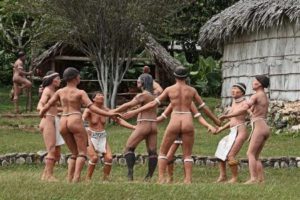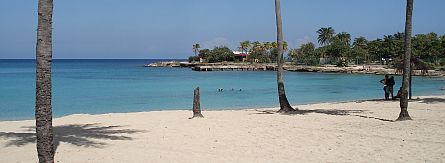![]() New archaeological information and historical presence of the Indian on the territory of the present province of Holguin between the 16TH and 19TH centuries, is a main objective of the Indian project in the province of Holguín: Archaeology and history, just take the Eastern Center of Archaeology Department, led by Dr. Roberto Valcarcel Rojas. The study sponsored by the Centre for research and environmental and technological services (Cisat) of the city of Holguin, the Ministry of science, technology and environment, will be extended through 2018, and counts with the support and participation of the University of Leiden, Netherlands.
New archaeological information and historical presence of the Indian on the territory of the present province of Holguin between the 16TH and 19TH centuries, is a main objective of the Indian project in the province of Holguín: Archaeology and history, just take the Eastern Center of Archaeology Department, led by Dr. Roberto Valcarcel Rojas. The study sponsored by the Centre for research and environmental and technological services (Cisat) of the city of Holguin, the Ministry of science, technology and environment, will be extended through 2018, and counts with the support and participation of the University of Leiden, Netherlands.
The study seeks to also recognize, archaeological and historical data with the emergence of the Indian colonial category in the territory of the present province of Holguin and how the Indian is inserted into the foundational action of the town of San Isidoro de Holguín.
The town, towards the beginning of the 18TH century took shape and forces, and grew as a strategic enclave in the northeast of the island. It brought together inhabitants who encouraged the exploitation of the lands of the great space and jostled to have a place. As part of the process, in 1736 the Governor of Santiago de Cuba, Don Pedro Ignacio Ximenes, on orders of the Captain General of the island, sends the Captain Don Pedro Raphael arrate and military engineer Don Joseph de el Monte and table to recognize the people.
That visit emerges an opinion of the population whose ethnic profile is summed up thus: ¨… 673 people while 86 are slaves and people domestic good nature and inclination work and good looking men most are white and of good color with blonde hair more than the children which should be attributed to the temperament of the waters… “.” The Indian term was well known at the time and referred to the descendants of indigenous people, particularly to those of the original population of Cuba.
Noted in the reports recognized as proven that for the first half of the 18TH century Eastern Cuba has a recognized presence of Indians and these are part of different events. There are at Baracoa, Bayamo, Santiago de Cuba and an entire people in El Caney; around 1700 is concrete foundation of the town of Jiguaní, promoted by an Indian and as a function of its people.
The report notes that “the Indians of the Caney revolt in 1758; This village militias and Tiguabos have an important role in the defeat of the English forces disembarking by Guantánamo Bay with the intention of attacking Santiago”.
Sure, “what would later become San Isidoro de Holguín had indigenous villages in its vicinity, at least since the 12TH century after Christ. We don’t know if these populations were still occupied at the time of the Spanish arrival, but the site that would later become known as the Yayal, three kilometers south of the town, concentrated population of indigenous origin during the 16TH century, as well as the fishing, about 13 km in the same direction. Archaeological data indicate that the Yayal continued inhabited in the 17TH century”.
Designates the Cuban researcher Valcarcel Rojas who according to historian Ignacio de Urrutia y Montoya many Indians “Selected with land north of Bayamo and will move to the parish that was founded in the area to fulfill religious obligations. This perspective is possible to follow them from the same process of formation of the parish church of San Isidoro, occurring in a region that round the area of what would become the village.” “It has its antecedents in a chapel established in Managuaco in 1692, later moved to Las Guasumas in 1709, and in 1716 in Cayo Llano, site on which would be the population of San Isidoro.
Indians relate to Managuaco find support also in archaeological investigations that suggest his presence at a location associated with the Treasury, end of the 17TH century or beginning of the 18TH”. “Behind these children there are families, sponsors, friends and an entire community who should participate in the foundational action of the priestly baptism of then and that for 1735 partly resides in the village. Likely its appearance to distinguish them but their names and baptism Act reflect the setting to the standards of the colonial society: Carlos, San Matheo Catharina, María Manuela, María de el Rosario, Grasiana, Luis Venancio, Joseph Santiago. Serian Creoles looking for its place in a difficult environment, which generally tended to discriminate against them”.
The Jiguaní and El Caney Indians created problems with their claims on lands and rights of Government. The Crown could fear a similar process if you are admitted to a significant presence of Indians in Holguin, and the local elite and Santiago, was not prepared to take risks.
In end, the authorities and inhabitants in Holguín was born ignoring them while other documents, such as baptisms, establish with certainty the Indian presence at the birth of the city.
Agencies/Arqueologia/Alexis red/Internet Photos / Arnoldo Varona / TheCubanHistory.com
THE CUBAN HISTORY, HOLLYWOOD.
![]() BÚSQUEDA HISTÓRICA DE LA POBLACIÓN ABORIGEN CUBANA. PRESENCIA EN HOLGUÍN, ORIENTE.
BÚSQUEDA HISTÓRICA DE LA POBLACIÓN ABORIGEN CUBANA. PRESENCIA EN HOLGUÍN, ORIENTE.
Obtener nueva información arqueológica e histórica sobre presencia del indio en el territorio de la actual provincia de Holguín entre los siglos XVI y XIX, es un principal objetivo del proyecto Indios en la provincia de Holguín: Arqueología e Historia, que acaba de emprender el Departamento Centro Oriental de Arqueología, liderado por el Dr. Roberto Valcárcel Rojas. El estudio patrocinado por el Centro de Investigaciones y Servicios Ambientales y Tecnológicos (Cisat) de la ciudad de Holguín, del Ministerio de Ciencia, Tecnología y Medio Ambiente, se extenderá hasta el 2018, y cuenta con el apoyo y la participación de la Universidad de Leiden, Holanda.
El estudio busca además reconocer, con datos arqueológicos e históricos, la emergencia del indio como categoría colonial en el territorio de la actual provincia de Holguín y de cómo el indio se inserta en la acción fundacional del pueblo de San Isidoro de Holguín.
La localidad, hacia inicios del siglo XVIII tomaba fuerzas y forma, y crecía como enclave estratégico en el nororiente de la Isla. Congregaba habitantes que fomentaban la explotación de las tierras de aquel gran espacio y pugnaban por hacerse un lugar. Como parte del proceso, en 1736 el Gobernador de Santiago de Cuba, Don Pedro Ignacio Ximenes, en razón de órdenes del Capitán General de la Isla, envía al capitán Don Pedro Raphael de Arrate y al ingeniero militar Don Joseph del Monte y Mesa a reconocer el pueblo.
De esa visita emerge un dictamen de la población cuyo perfil étnico se resume así: ¨…673 personas aunque 86 son esclavos y gente doméstica de buena índole e inclinación hombres de trabajo y buen aspecto más son blancos y de buena color con cabello rubio los más de los niños lo cual debe atribuirse al temperamento de las aguas…”. El término indio estaba bien reconocido en la época y designaba a los descendientes de indígenas, particularmente a los de la población original de Cuba.
Se señala en los informes reconocidos como probados que para la primera mitad del siglo XVIII el oriente cubano tiene una reconocida presencia de indios y estos son partícipes de distintos acontecimientos. Los hay en Bayamo, Baracoa, Santiago de Cuba y todo un pueblo en El Caney; hacia 1700 se concreta la fundación del pueblo de Jiguaní, promovida por un indio y en función de su gente.
En el informe se señala que “Los indios de El Caney se sublevan en 1758; las milicias de este pueblo y las de Tiguabos tienen un papel importante en la derrota de las fuerzas inglesas que desembarcan por la bahía de Guantánamo con la pretensión de atacar Santiago”.
Se asegura que, “Lo que después sería San Isidoro de Holguín tenía aldeas indígenas en sus inmediaciones, al menos desde el siglo XII después de Cristo. No sabemos si estas poblaciones aún estaban habitadas al momento del arribo español, pero el sitio que posteriormente se conocería como El Yayal, tres kilómetros al sur del pueblo, concentró población de origen indígena durante el siglo XVI, al igual que El Pesquero, a unos 13 kilómetros en la misma dirección. Los datos arqueológicos indican que El Yayal continuó habitado en el siglo XVII”.
Señala el investigador cubano Valcárcel Rojas que según el historiador Ignacio de Urrutia y Montoya muchos indios “son beneficiados con tierras al norte de Bayamo y van a moverse al curato que se funda en la zona para cumplir con las obligaciones religiosas. Desde esta perspectiva es posible seguirlos a partir del mismo proceso de formación de la iglesia parroquial de San Isidoro que se da en una región que ronda el área de lo que sería el pueblo”. “Esta tiene sus antecedentes en una ermita establecida en Managuaco en 1692, posteriormente movida a Las Guasumas en 1709, y fijada en 1716 en Cayo Llano, sitio sobre el que se establecería la población de San Isidoro.
La relación de los indios con Managuaco encuentra apoyo además en investigaciones arqueológicas que sugieren su presencia en una locación asociada a dicha hacienda, a fines del siglo XVII o inicios del XVIII”. “Detrás de estos niños hay familias, padrinos, amigos, toda una comunidad que debió participar en la acción fundacional del bautismo sacerdotal de entonces y que para 1735 en parte reside en el pueblo. Es probable que su fisonomía los distinguiera pero sus nombres y el acto de bautizo reflejan el ajuste a la normas de la sociedad colonial: Carlos, Catharina de San Matheo, María Manuela, María del Rosario, Grasiana, Luis Venancio, Santiago Joseph. Serian criollos buscando su lugar en un entorno difícil, que por regla general tendía a discriminarlos”.
Los indios de Jiguaní y El Caney creaban problemas con sus reclamaciones sobre tierras y derechos de gobierno. La corona podía temer un proceso similar si se admitía una presencia importante de indios en Holguín, y la elite local y de Santiago, no estaba dispuesta a correr riesgos.
En fin, las autoridades y habitantes establecidos en la ciudad de Holguín nacía ignorándolos aunque otros documentos, como los bautizos, establecen con total certeza la presencia india en el nacimiento de la Ciudad.
Agencies/Arqueologia/Alexis Rojas/Internet Photos/ Arnoldo Varona/ TheCubanHistory.com
THE CUBAN HISTORY, HOLLYWOOD.










